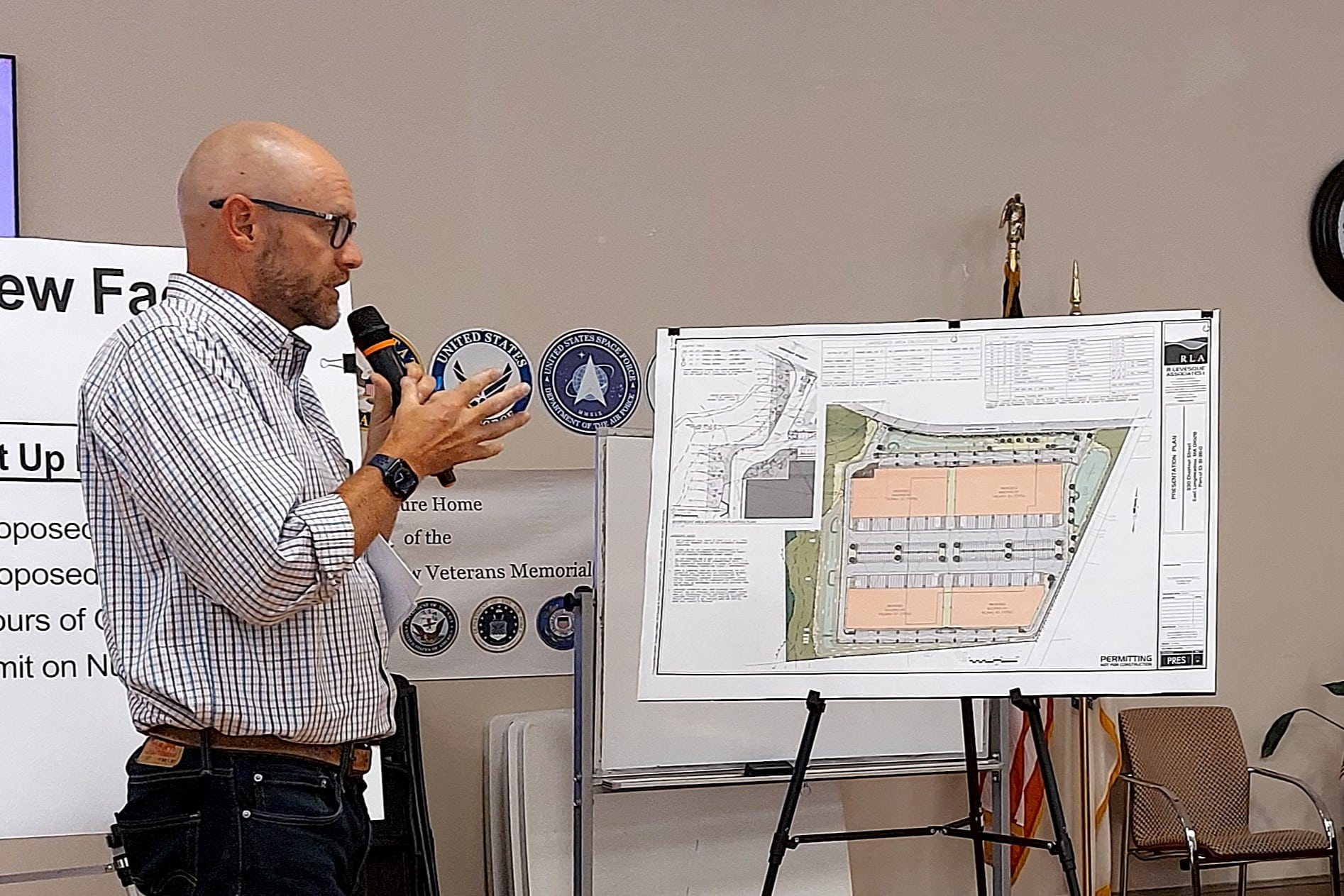Rob Levesque of Levesque Associates presents the East Longmeadow Planning Board with plans for a complex of four warehouses at 330 Chestnut St.
Reminder Publishing photo by Sarah Heinonen
EAST LONGMEADOW — With a failed attempt to site a warehouse at 330 Chestnut St. fresh in the minds of residents, East Longmeadow Redevelopers, LLC brought a new plan for the site to the Planning Board on Sept 3.
In 2023, the developers proposed a 560,000-square-foot warehouse with 100 loading docks that could accommodate up to four businesses. Residents of the Fields at Chestnut condominiums, which abuts the property, objected to the construction of a warehouse on the site, despite the land being zoned to allow such use.
After several months of public hearings, the board approved the warehouse, but later revoted the matter, denying the project because the DPW, Fire and Police departments had expressed concerns about previously approved site conditions. Without those conditions in place, the board was no longer comfortable approving the project. The developers appealed the issue to the state Land Court, but when it was sent back to the Planning Board, the project was denied a second time.
Planning Board Chair Russell Denver began the meeting by explaining the board’s legal obligations. A warehouse is an “as of right” use in the town’s industrial garden park zone, meaning that land can be used for that purpose, provided it meets bylaw and zoning requirements. To ensure it meets these requirements, the Planning Board conducts a site plan review. During the review, the board is allowed to consider the site’s features, landscaping, traffic, parking and stormwater design. The land’s use as a warehouse and which businesses might lease space on the property were not up for discussion at the meeting, Denver said.
Denver also took a moment to caution members of the public and the attorneys who would be speaking against yelling, “theatrics” or accusations that the Planning Board was biased toward the developers, which had occurred during the board’s consideration of the first project. He said such accusations would result in a complaint to the state attorney general’s office.
The new plans for the site were presented by landscape architect Rob Levesque, of R. Levesque Associates. Rather than one large warehouse, the site would contain four warehouses and be about 100,000 square feet smaller in total than the previous design, a reduction of 20%. The layout would include 108 loading docks and 138 trailer-truck parking spaces. The docks and parking spaces for the trucks would be limited to the center of the property, with the warehouses blocking their view from Chestnut Street or abutters at the rear of the site. The front and back of the property would be reserved for up to 398 employee passenger vehicles.
During the hearings around the 2023 proposal for a warehouse, traffic congestion was the neighbors’ main concern. Many people questioned the validity of the traffic study performed by Bowman Consulting Group, despite an independent peer review attesting to its methodology.
Traffic studies are conducted using standardized land use codes from the Institute of Traffic Engineers. Each land use generates an estimated number of trips per square foot of space. Rather than simply use a “warehouse” land use for this project, as had been done in 2023, traffic engineer and Bowman Consulting Group Branch Manager Jason Adams went with a “conservative approach.” He used a warehouse code, which assumes more heavy trucks than passenger vehicles, for two of the four buildings and, for the other two, inserted a “light industrial” land use. The light industrial use reflects more passenger vehicles than heavy trucks. He said the goal of blending the two uses was to provide for a range of possibilities.
Combining the estimated truck trips from the site and counts of existing traffic that were collected in June, the new traffic study estimated there would be between 95 and 100 additional truck trips after the project is built. That is less than one-third of the truck trips that were estimated for the 2023 warehouse plan. Adams estimated the trucks leaving the site would be evenly split, with half turning left toward the intersection of Chestnut Street and Dwight Road, and the other half turning right toward the Chestnut Street and Shaker Road intersection.
Intersections are judged using a letter scale, with A for those with the fastest, most freely flowing traffic and F for the most congested ones. Adams said the project would “not [result in] a significant impact” on either the Shaker Road or Dwight Road intersections with Chestnut Street. The intersection with Shaker Road is rated a C and would remain so during peak morning traffic. It would be downgraded to a D during peak afternoon traffic flow. Adams noted that a service level of D or above is considered “acceptable” by the industry. Nonetheless, he suggested signal changes at the intersection to ease the flow of traffic.
A resident of the Fields at Chestnut said the Fire Department does not send firetrucks through the Shaker Road and Chestnut Street intersection because of difficulty navigating among the traffic there. She said tractor trailers would have comparable difficulties. Resident Lynn Silverstein said Chestnut Street is “a narrow little two-lane road” and expressed concern about trucks navigating it in inclement weather.
Adams played a video of truck traffic turning south from Chestnut Street onto Shaker Road. The vehicle successfully navigated the turn, even with a passenger vehicle in the opposite lane on Shaker Road. Resident Roland Bolduc, who drives tractor trailer trucks, said that whether a driver can make the turn depends on their experience, as well as the length and type of trailer they are hauling.
Bolduc also discounted Adams’ assertion that the truck drivers will not drive through the rotary at the center of town because of existing traffic patterns. He said they will follow the route laid out by their GPS.
Attorney Michael Pill of Green Miles Lipton, LLC, represented the Fields at Chestnut Condominiums at the hearing. He said the video shown by Adams illustrates how tight the intersection is. He predicted that the buildings would be “high cube” warehouses, which he said have a higher volume of truck traffic than other warehouses. He also urged the Planning Board to consider adding a condition that traffic coming from the warehouses only be delivered to commercial operation, rather than direct to home deliveries.
Denver asked one of the developers how many employees the warehouses would hire and how much revenue the project would be added to the tax roles as a result of improving the property. While the number of employees would depend on which businesses leased the warehouses, he estimated that the property would have a tax valuation over $40 million.
Fields at Chestnut resident Mary Hurley said the new project was a “regifting of the original plan” and, while the use of the land was not a topic that the board was able to consider, she said it matters to her “quality of life.”
Dick Leopold, a resident of the Fields at Chestnut, asked about the impact of idling trucks on air quality. Denver said that a baseline air quality report was a condition of the 2023 plan, as was exhaust filters on idling trucks. Bolduc said exhaust filters do not work because they are difficult to install.
Marilyn Richards, a town councilor who was speaking as a resident, commented that when the Center Square plaza was built, residents had “no idea” if there would be traffic congestion. A mitigation plan was created, but its implementation was never needed because people tend to find traffic routes to avoid congestion. She suggested a mitigation plan be considered for this project to put people’s minds at ease.
Like his council colleague, Ralph Page made suggestions for project conditions. He said automated signals where the rail trail intersects with Chestnut Street would eliminate the need for walkers and bikers to remember to push the button to alert drivers that they were crossing. He also suggested landscaping to shield the property from view along the rail trail.
Denver said the Planning Board is trying to be transparent in their handling of the project. At the next public hearing on the matter, scheduled for Oct. 7, the board will gather more information from the developers’ team, residents and Pill. He said the Planning Board must answer the question, “What is in the best interest of the entire town?”
Editor’s note: This article has been amended to include the correct date for the next Planning Board hearing for the project, which is Oct. 7. It also has been updated to include the correct estimated tax valuation for the property, which is expected to be over $40 million.



